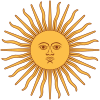
Argentina
Country in South America / From Wikipedia, the free encyclopedia
Dear Wikiwand AI, let's keep it short by simply answering these key questions:
Can you list the top facts and stats about Argentina?
Summarize this article for a 10 years old
Argentina (Spanish pronunciation: [aɾxenˈtina] ⓘ), officially the Argentine Republic[upper-alpha 1] (Spanish: República Argentina), is a country in the southern half of South America. Argentina covers an area of 2,780,400 km2 (1,073,500 sq mi),[upper-alpha 2] making it the second-largest country in South America after Brazil, the fourth-largest country in the Americas, and the eighth-largest country in the world. It shares the bulk of the Southern Cone with Chile to the west, and is also bordered by Bolivia and Paraguay to the north, Brazil to the northeast, Uruguay and the South Atlantic Ocean to the east, and the Drake Passage to the south. Argentina is a federal state subdivided into twenty-three provinces, and one autonomous city, which is the federal capital and largest city of the nation, Buenos Aires. The provinces and the capital have their own constitutions, but exist under a federal system. Argentina claims sovereignty over the Falkland Islands, South Georgia and the South Sandwich Islands, the Southern Patagonian Ice Field, and a part of Antarctica.
Argentine Republic[upper-alpha 1] | |
|---|---|
Motto:
| |
| Anthem: Himno Nacional Argentino ("Argentine National Anthem") | |
| Sol de Mayo[2] (Sun of May)  | |
.svg/220px-ARG_orthographic_(+all_claims).svg.png) Argentine territory in dark green; territory claimed but not controlled by Argentina in light green | |
| Capital and largest city | Buenos Aires 34°36′S 58°23′W |
| Official languages | Spanish[lower-alpha 1] |
| Co-official languages | |
| Religion (2022)[7] |
|
| Demonym(s) |
|
| Government | Federal presidential constitutional republic |
| Alberto Fernández | |
| Cristina Fernández de Kirchner | |
| Agustín Rossi | |
| Cecilia Moreau | |
| Horacio Rosatti | |
| Legislature | National Congress |
| Senate | |
| Chamber of Deputies | |
| Independence from Spain | |
| 25 May 1810 | |
• Declared | 9 July 1816 |
| 1 May 1853 | |
| Area | |
• Total | 2,780,400 km2 (1,073,500 sq mi)[upper-alpha 2] (8th) |
• Water (%) | 1.57 |
| Population | |
• 2023 estimate | 46,621,847[9] (33rd) |
• 2022 census | 47,327,407 [10] (31st) |
• Density | 14.4/km2 (37.3/sq mi)[8] (214th) |
| GDP (PPP) | 2023 estimate |
• Total | |
• Per capita | |
| GDP (nominal) | 2023 estimate |
• Total | |
• Per capita | |
| Gini (2020) | medium |
| HDI (2021) | very high · 47th |
| Currency | Argentine peso ($) (ARS) |
| Time zone | UTC−3 (ART) |
| Date format | dd/mm/yyyy (CE) |
| Driving side | right[lower-alpha 2] |
| Calling code | +54 |
| ISO 3166 code | AR |
| Internet TLD | .ar |
The earliest recorded human presence in modern-day Argentina dates back to the Paleolithic period.[14] The Inca Empire expanded to the northwest of the country in Pre-Columbian times. The country has its roots in Spanish colonization of the region during the 16th century.[15] Argentina rose as the successor state of the Viceroyalty of the Río de la Plata,[16] a Spanish overseas viceroyalty founded in 1776. The declaration and fight for independence (1810–1818) was followed by an extended civil war that lasted until 1861, culminating in the country's reorganization as a federation. The country thereafter enjoyed relative peace and stability, with several waves of European immigration, mainly Italians and Spaniards, influencing its culture and demography.[17][18][19][20]
The almost-unparalleled increase in prosperity led to Argentina becoming the seventh-wealthiest nation in the world by the early 20th century.[21][22][23] In 1896, Argentina's GDP per capita surpassed that of the United States,[24] and was consistently in the top ten before at least 1920;[25][26] Argentina remained among the fifteen richest countries for several decades.[21] Following the Great Depression in the 1930s, the country descended into political instability and economic decline that pushed it back into underdevelopment,[27] being currently ranked 62nd in the world. Following the death of President Juan Perón in 1974, his widow and vice president, Isabel Perón, ascended to the presidency, before being overthrown in 1976. The following military junta, which was supported by the United States, persecuted and murdered thousands of political critics, activists, and leftists in the Dirty War, a period of state terrorism and civil unrest that lasted until the election of Raúl Alfonsín as president in 1983.
Argentina is a regional power, and retains its historic status as a middle power in international affairs.[28][29][30] A major non-NATO ally of the United States,[31] Argentina is a developing country with the second-highest HDI (human development index) in Latin America after Chile.[32] It maintains the second-largest economy in South America, and is a member of G-15 and G20. Argentina is also a founding member of the United Nations, World Bank, World Trade Organization, Mercosur, Community of Latin American and Caribbean States and the Organization of Ibero-American States. It is expected to join BRICS on the 1st of January 2024.[33]

